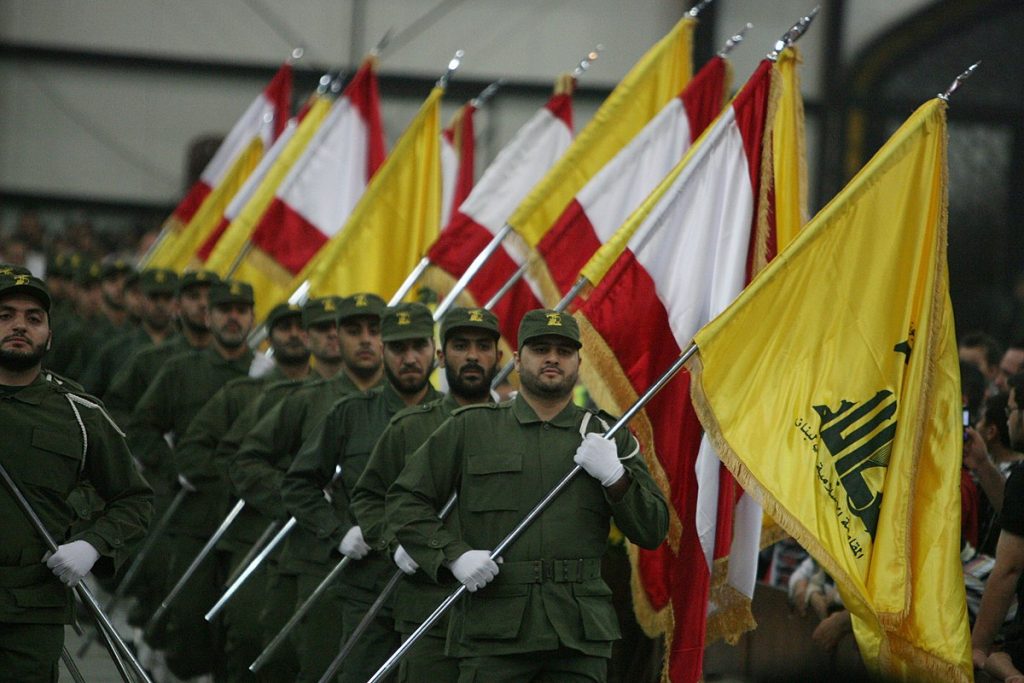
Photo: khamenei.ir, CC BY 4.0, via Wikimedia Commons
“The enemy is on the defensive — we have always been on the defensive, now we are in attack mode,” Hezbollah’s leader, Hassan Nasrallah (pictured), declared last week. Although he has often issued blood-curdling threats against Israel, this was no mere sabre-rattling by the terror group head.
As a newly updated report from BICOM reveals, Hezbollah is engaged in a potentially deadly precision missile project – one which could make the 2006 Second Lebanon War pale by comparison. The project, warns the report, “would enable the Lebanese group to accurately target critical Israeli infrastructure and constitutes a significant threat to Israel’s security”.
With the correct infrastructure in place, the Iranian-backed effort to upgrade Hezbollah’s large arsenal – said to comprise some 100,000-130,000 rockets – is both quick and relatively cheap. “Dumb” missiles – those which do not have precision capability – can be converted in a matter of hours at a cost of $5,000-$10,000.
The new initiative involves the fitting of GPS guidance packs on to medium-range Zelzal-2 missiles. Hezbollah is believed to have a stock of some 14,000 of these missiles already located in Lebanon.
With the assistance of Tehran, which supplies the components, the terror group has so far upgraded between 20 and 200 of its missiles.
However, warns the BICOM study, “even a small number of missiles could do serious damage to Israel – which is a small, densely populated country with all its key industrial and critical infrastructure sites concentrated in a small number of locations”. Israel’s most populated cities, power stations, international airport and two of its three commercial ports are located in an area 20km wide and 80-100km in length. Hezbollah has previously vowed to attack Israel’s nuclear reactor, power stations, Haifa oil refinery, as well as military targets.
With the outbreak of the Syrian civil war, in which both Iran and Hezbollah were actively engaged on behalf of the Assad regime, Tehran attempted to supply precision missiles to its proxy army. Israel stated that the supply of this “tie-breaking” weaponry was a red line and – while trying desperately not to become entangled in the conflict – attacked storage facilities, weapons convoys and research and production facilities in Syria. This effort is believed to have been largely successful, prompting Iran to switch to the new tactic of upgrading Hezbollah’s existing missile supply.
Missile components – for instance, GPS guidance packs, command and guidance systems, control systems, and small winglets or canards – are being transported by land and air. The former sees the components – which are the size of small suitcases – shipped from Iran via Iraq to Syria and then on to Lebanon. The latter involves the components being flown to Damascus airport, where they are often stored, on leased commercial airliners. Iran is also arming Shia militias in Iraq with precision missiles.
The Iranian Revolutionary Guard, which oversees and runs the project, has trained hundreds of Lebanese specialists at its campus at the Imam Hussein University in Tehran so that they are capable of carrying out the retrofitting process in small sites back in Lebanon. Although commonly described as factories, many are much smaller than the image this conjures. “They’re not huge hangars like people imagine, it could be a [small] room,” stated one senior Israeli military officer earlier this year.
The IRGC had made no secret of its plans, while Hezbollah has also boasted that it now has a precision missile capability. “I tell [Israel] no matter what it did to cut the route, it is over. It has already been achieved,” Nasrallah claimed last year. “Hezbollah now possesses precision missiles and non-precision weapons capabilities.”
Israel does not dispute that this is the case, while disputing that the terror group yet is yet engaged in an industrial-scale upgrading. The former deputy head of Mossad has thus suggested that Hezbollah has received “small numbers of GPS precision-guided systems that will help it to convert some heavy missiles into accurate missiles”.
Keen to avoid becoming engaged in a wider war with Hezbollah in Lebanon, Israel has adopted a measured response. Nonetheless, it has also signaled that it will not sit idly by while Hezbollah is able to enhance the quality of its arsenal. In August, Israeli forces are said to have been responsible for the firing of two small drones at a site in the Hezbollah stronghold of Dahiyeh in Beirut. The target was components that were being stored after being flown into Beirut airport, before being dispatched to a missile factory. Last month, Israel also revealed images of a missile factory in Lebanon’s Bekaa Valley.
The chaos and blood-shed that would be wrought by a war between Israel and Lebanon is indisputable. In 2006, Hezbollah fired an average of 118 short-range missiles without a precision capability a day at Israel. It is now estimated that the terror group could fire 1,200 missiles a day. It also now has the capacity to hit targets across Israel, including the Red Sea resort of Eilat in the far south of the country.
Rather than engaging in a war, Israel wants the Lebanese government, the Lebanese Armed Forces and the UN Interim Force in Lebanon (UNIFIL) to take action against Hezbollah and Iran. UN Security Council Resolution 1701, which ended the 2006 war, specifically barred the “sale or supply of arms and related material to Lebanon except as authorised by its government”. Iran has repeatedly violated this resolution.
Given Hezbollah’s political and military sway within Lebanon, action by its government is unlikely. International action in support of Israel is therefore necessary. As BICOM suggests: “One option would be to publicly warn Hezbollah and the Lebanese government that they are aware of the precision project and to make clear that the project is a direct violation of UN Security Council Resolution 1701. If these warnings fail to make an impact then they should consider initiating tough sanctions against those involved in the project from Hezbollah and the IRGC.”


